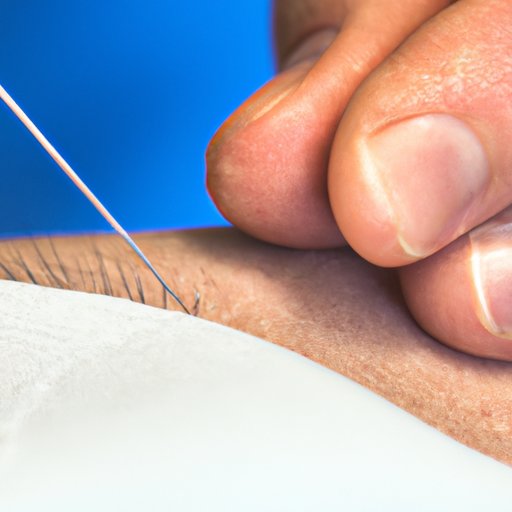
Introduction
Dry needling is a treatment that has been gaining popularity in recent years as a pain relief technique in physical therapy. Many are curious about its effectiveness and safety as an alternative form of therapy. While dry needling is not suitable for everyone, it has been shown to have benefits when used appropriately and in conjunction with other forms of physical therapy.
The Benefits and Risks of Dry Needling in Physical Therapy: A Comprehensive Guide
Dry needling involves inserting a thin needle into a muscle trigger point, often used in conjunction with other types of physical therapy treatments. The needle is dry, meaning no medication or fluid is injected into the muscle. It works by creating a tiny lesion in the muscle, which stimulates the healing process.
Many individuals turn to dry needling for pain management and to treat symptoms of various conditions such as low back pain, headaches, tendinitis, and other muscle-related issues. Studies have shown that dry needling can help reduce pain, muscle tension, and improve range of motion. It can also be used in injury prevention and recovery.
However, as with any treatment, there are risks and potential side effects. These can range from minor discomfort to more severe muscle soreness and bruising. It is crucial to understand these risks before undergoing any dry needling therapy.

Dry Needling vs. Acupuncture: Understanding the Key Differences
Although dry needling and acupuncture both utilize needles, they are different techniques. Acupuncture is an ancient Chinese medical practice that follows the belief that life energy or qi flows throughout the body via pathways called meridians. Acupuncture seeks to balance this energy flow through the insertion of needles at specific points that align with these meridians.
Dry needling, on the other hand, involves the insertion of needles directly into specific trigger points in the muscle, all aimed at relieving pain or tension. It is a Westernized medical technique. Because dry needling is a newer form of therapy used in conjunction with other treatments, it is more commonly used in physical therapy than acupuncture.
Three Case Studies: How Dry Needling Can Help with Chronic Pain Management
Here are three cases of individuals who have benefited from dry needling in their physical therapy:
Case Study 1: How dry needling helped with a patient’s shoulder pain
John was a 40-year-old office worker who presented at our clinic with complaints of right shoulder pain. He was unable to lift his arm above shoulder height and had been experiencing this pain for six months. An MRI showed severe rotator cuff tendonitis and mild bursitis. After four weeks of physical therapy, including five sessions of dry needling, John returned to his job pain-free, with full range of motion restored.
Case Study 2: How dry needling aided in managing headaches
Ricky, a 32-year-old elementary school teacher, had been experiencing headaches for six months. After undergoing a thorough evaluation, physical therapy, including dry needling was recommended. The treatment plan consisted of two sessions per week for four weeks. The patient was advised to monitor his pain level and symptoms. By the fourth session, the patient reported a 50% decrease in headaches and complete resolution of neck pain. The patient’s symptoms had been managed for six months when he last visited the clinic.
Case Study 3: How dry needling addressed chronic pain in a patient’s back and hips
Becky, a 54-year-old homemaker, had been experiencing pain in her back and hips for six months. Her pain was particularly worse on her right side, causing her to limp and making it difficult to stand or climb stairs for an extended time. After a physical examination, the patient received dry needling treatment on tender points while undergoing physical therapy. After four weeks of treatment, Becky’s pain was reduced, and she was able to walk without a limp.
Top 5 Things to Know Before Trying Dry Needling at Your Next Physical Therapy Session
Here are the top five things you should know before considering dry needling during your physical therapy session:
1. Explanation of what to expect during a dry needling session
Your therapist will use a thin, solid needle to insert into your muscle trigger points. Typically, there is no medication or anesthetic involved, and the number of needles will vary depending on the muscle being targeted.
2. Preparation for a dry needling session
Wear comfortable clothing that provides easy access to the targeted area. You may be positioned to lie down or sit during the procedure, depending on the muscle the physical therapist is targeting.
3. Key things to keep in mind before trying dry needling
Dry needling is not recommended if you have certain medical conditions such as an aversion or fear of needles or are taking blood-thinning medication. You should always consult your doctor before considering it. It’s also crucial to understand the potential risks of dry needling, including muscle soreness or stiffness after treatment.
Expert Opinions: Physical Therapists Weigh in on the Effectiveness of Dry Needling
There has been an increasing debate on the effectiveness and safety of dry needling as an alternative form of therapy. Physical therapists weigh in on the subject, sharing their professional opinions and expertise. While some express concerns over the safety of the procedure, many agree that, when used correctly, dry needling can have a significant impact when utilized in conjunction with other forms of physical therapy.
A Beginner’s Guide to Dry Needling in Physical Therapy: What to Expect and How It Works
Here is a step-by-step explanation of the dry needling procedure:
Step 1: Evaluation of the patient
The physical therapist evaluates the patient’s medical history and forms a diagnosis based on their complaints.
Step 2: Trigger point identification
The physical therapist will identify the trigger points that correspond to the patient’s issue and mark the sites to prepare for the needle’s insertion.
Step 3: Needle insertion
The physical therapist will insert sterile, thin needles through the skin to reach the targeted muscle trigger points.
Step 4: Muscle stimulation
The needle creates a small lesion in the muscle, leading to stimulation of the muscle fibers and an involuntary contraction without pain.
Step 5: Removal of the needles
The physical therapist will remove the needles after completing the procedure, and the patient can typically go about their daily activities.
Frequently Asked Questions about Dry Needling in Physical Therapy: Get the Answers from Experts
Here are some of the most frequently asked questions about dry needling:
Is dry needling painful?
Patients may feel a slight prick or discomfort at the needle’s insertion site. This sensation is typically short-lived and often accompanied by a feeling of tension release, reducing the pain.
What are the risks of dry needling?
Common side effects of dry needling include muscle soreness, redness, and bruising. Riskier ones involve puncturing of internal organs or infections.
Who can perform dry needling?
Dry needling is a particular skill commonly practiced by licensed physical therapists in many states. It’s essential to check the credentials of the physical therapist before undergoing the procedure.
Conclusion
Dry needling is a promising form of therapy for pain management and symptom relief when utilized alongside other forms of physical therapy. While understanding its benefits and possible risks, it is crucial to consult a licensed physical therapist or physician. Patients should not disregard the advice of their physician regarding other treatment options that they deem more appropriate to their condition.




